Churches Saint-Mark | Miracoli | Stefano | Zaccaria | Murano | Chorus | Mass Hours
Saint-Mark Art Story | Location | Opening Hours Tickets | Authorizations
Art Story Saint Mark's Body | History | Byzantine | Domes and Horses
Saint-Mark Golden Basilica Sanctuary, Domes and Horses, in Venice Italy
St. Mark: A Low-rise Basilica
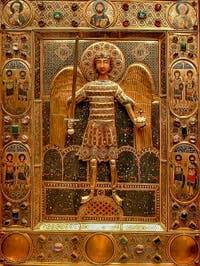
Saint-Mark Treasure Compared to its European contemporaries, the height of St. Mark's Basilica is remarkably modest.
At the same time, we saw that the construction of this third basilica responded more to political than religious considerations and that it had to be a grandiose building capable of impressing the world.
So why did they make it so modest in terms of its height?
There are several reasons for this.
The first is in Venice itself; it should not be forgotten that everything is built on water and that weight is an element that should be taken into account for any construction on stilts, be it a basilica or any Venetian palace.
Indeed, many bell towers in Venice are close to 90 metres in height, but, as is known, many of them have collapsed, starting with that of Saint Mark, whose collapse of 1902 was not the first.
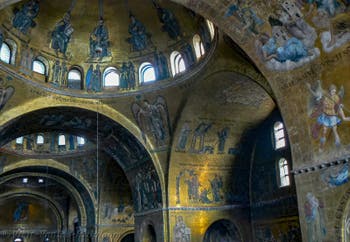
Saint-Mark Apse's Mosaics The second reason is that at that time, the current Piazza, between the Doge's Palace and the Marciana Library, did not exist.
It was still a dock that gave directly into the lagoon and stopped on the southern side of St. Mark's Basilica.
In front of the basilica, the dock ended into a canal that met the Rio di Palazzo.
All this meant that the southern part and south-eastern part of the basilica were fully reflected in the water, which “grew” the perspective.
Later, during the 12th century, the dock and canal were filled, questioning the basilica's “visual” appearance by changing its primitive spatial relationship.
The Domes of St. Mark's Basilica
Until the beginning of the 13th century, the basilica was significantly lower, outwardly speaking, than today.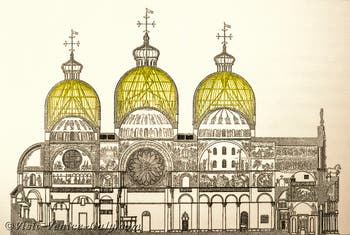
Timber Structures of the cupolas This interior-outer distinction is essential in the sense that if the domes of St. Mark's Basilica have actually been raised, only the outer "visible" part of it is heightened, without modifying the arches of the internal cupolas.
It simply means that the outer cupolas, made of a wooden frame and lead plates to cover it, just contain emptiness and are standing well above the inner cupolas of the basilica.
By this visual artifice, they were able to fill the lack of “visual” height, born after the disappearance of the canal and the dock and this by artificially heightening the cupolas of the basilica of Saint Mark.
It is true that when you are on St. Mark's Square, at the other end of it, the basilica of St. Mark seems very small in proportion to the square.
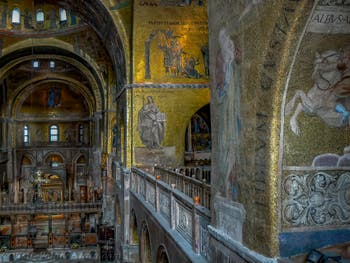
Saint-Mark Apse's Mosaics The church is, in fact, on the outside, significantly wider than tall, which amplifies this visual effect of small size.
And this is perhaps one of the most beautiful surprises St. Mark's Basilica can offer to its visitors.
Crossing its threshold, you expect to enter a “small” church and barely have you entered that you are genuinely grasped by the imposing height of its domes.
Indeed, once inside St. Mark's Basilica, it is suddenly you who feel small.
Since then, it seems no longer so small, and, like many things in Venice, we have to know how to approach them without a priori to be able to see them better and appreciate them.
So let's forget about the lengths, widths and angles! Beauty is not to be measured!
The Horses of St. Mark Basilica: The Quadriga
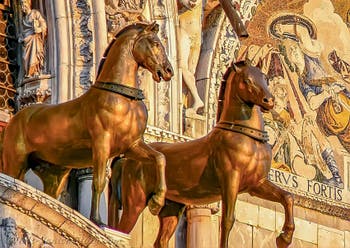
Saint-Mark Basilica's Horses The horses of St. Mark appeared long after the third construction of St. Mark's Basilica.
They were a war trophy stolen in 1204 by the Venetians in Constantinople.
The Doge Enrico Dandolo sent them to Venice at the time of the fourth crusade, which had seen the Crusaders' capture of Constantinople, thanks to the help of the Venetians.
These horses belonged to an imperial quadriga coming from the island of Chios.
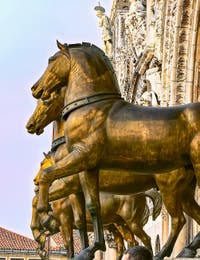
Saint-Mark's Horses They were then sent to Constantinople, where they were positioned on the high towers of the hippodrome.
On their origin, opinions diverge; some historians consider the Corinthian source, from the 4th or 3rd century BC.
Others say that they were made by Lysippos of Sicyon, a Greek sculptor and bronzer, for Alexander the Great, and that Tiridates I, king of Armenia, owned them and then offered them to Nero, in exchange for the crown he received from his hands.
After this gift, they would have been placed at the four corners of the colossal statue of Nero in Rome.
They were then transported by Emperor Constantine to Byzantium.
When they arrived in Venice, they were first stored at the Arsenal before being installed at the top of the basilica to reinforce its symbolic power.
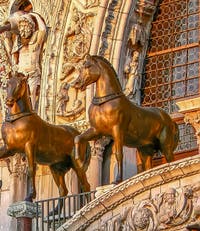
Saint-Mark's Horses
“Before St. Mark still glow his steeds of brass,
Their gilded collars glittering in the sun;
But is not Doria's menace come to pass?
Are they not bridled !”
Lord Byron - Childe Harold Canto IV-XIII
To understand this allusion to Doria, it is worth knowing that the horses of St. Mark had become one of the symbols of Venetian power.
Pietro Doria, the Genoese admiral, promised in 1378 to the Venetians, during the war between Genoa and Venice, that after the Genoese capture of the island close to Chioggia, he would bridle the horses of Venice. What he did not succeed in doing!
Byron's poem was written after the fall of Venice and its occupation by Austrian troops.
St. Mark Basilica: “Light as Deer”
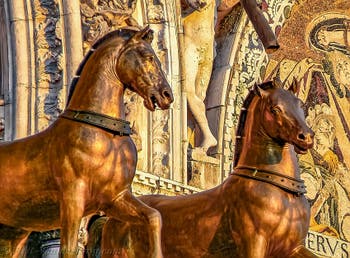
Saint-Mark Basilica's Horses
“I was looking closely at the four bronze horses placed above the arcades of St. Mark's Church.
What a beautiful hitch!
I would have liked to hear him judge by a real horse connoisseur.
Seen on the terrace that supports these horses, they seem very heavy, but when you look at them from below, that is, from St. Mark's Square, they look light as deer.“
Goethe Memoirs - October 8 1786
These horses are indeed made to be watched from St. Mark's Square, and it is no wonder that Schopenhauer did not appreciate them at their fair value when he had the opportunity to see them in Paris, out of their context, and at a wrong level:
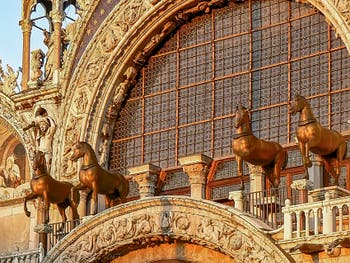
Saint-Mark Basilica's Horses
“It is in Paris, in the Tuileries Garden that in front of the castle, there are the famous four horses that Bonaparte brought back from Venice and which have always accompanied the conquerors.
But I don't find them as extraordinary as I imagined.“
Schopenhauer
They had indeed been stolen by Napoleon Bonaparte in Venice on December 7, 1797 and were not returned until 1815, where they return to their place on the Basilica Terrace.
They left their place twice again, but this time to protect them, during the first and last world war.
Finally, the horses you see today on the basilica are copies; the real horses, even more beautiful, are inside the church, in the museum of St. Mark's Basilica, sheltered from the bad weather.
Mosaics of St. Mark's Basilica in Venice
One of the most beautiful things that St. Mark's Basilica can offer to its visitors is undoubtedly its mosaics, both outside and inside it.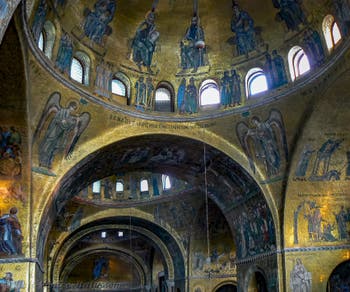
Saint-Mark Apse's Mosaics They were initially highly Byzantine-inspired, and it is even believed that some Byzantine artists would have come to Venice especially to make them.
However, we do not have proof of this, especially since most of the original mosaics of the basilica have been replaced.
Their maintenance was indeed delicate, and most of the original mosaics deteriorated quickly, resulting in near-constant restorations.
Thus, rather than restoring existing mosaics, the Venetians, as they went on, simply replaced them with new mosaics, representing scenes that often correspond more to the moment's artistic tastes and religious themes.
The only original mosaic on St. Mark's facade represents the translation of the remains of Saint Mark on a background that represents the basilica around 1250.
Art Story Saint Mark's Body | History | Byzantine | Domes and Horses
Saint-Mark Art Story | Location | Opening Hours Tickets | Authorizations
Churches Saint-Mark | Miracoli | Stefano | Zaccaria | Murano | Chorus | Mass Hours
Back to Top of Page

